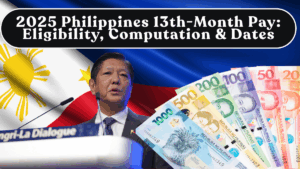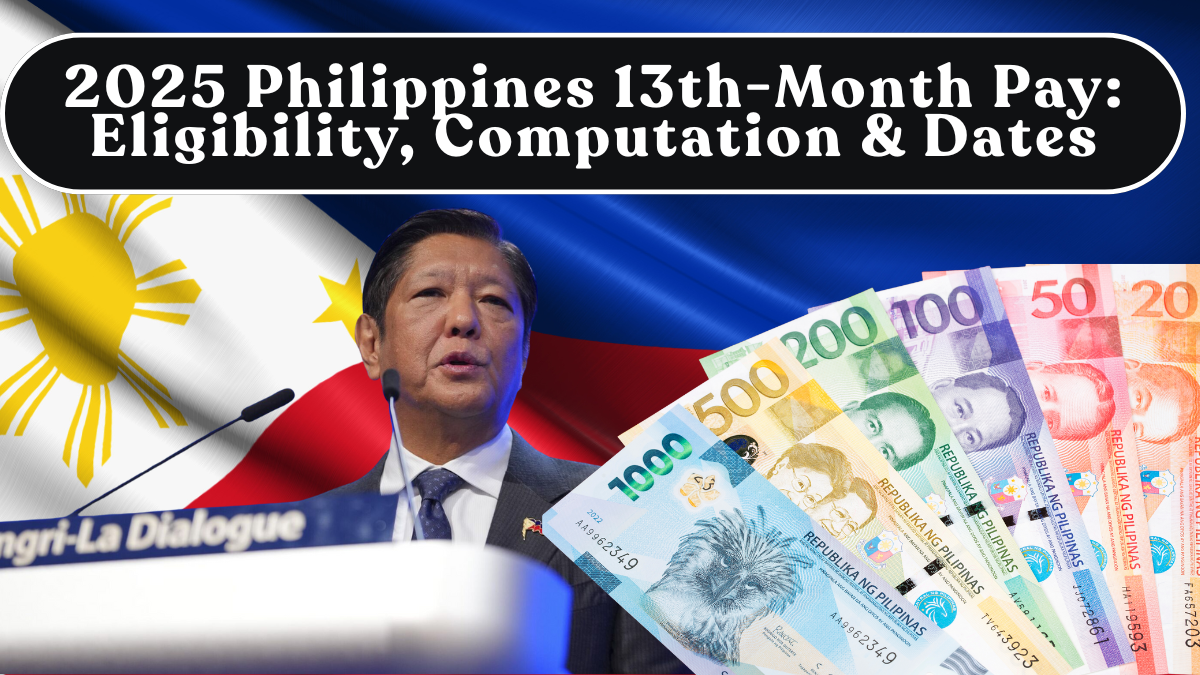As the holiday season approaches, thousands of Filipino workers look forward to their much-deserved 13th-month pay, a mandatory bonus that provides financial relief during December’s high-spending period. For 2025, the Department of Labor and Employment (DOLE) has once again emphasized that all qualified employees must receive their full 13th-month pay on or before December 24, 2025, as stipulated under Presidential Decree No. 851.
The 13th-month pay serves as a year-end benefit — a way of sharing company success with employees while boosting purchasing power and morale nationwide. Here’s everything you need to know this year, from eligibility rules and computation formulas to important payment deadlines.

What Is the 13th-Month Pay?
The 13th-month pay is a mandatory monetary benefit equal to one-twelfth (1/12) of an employee’s basic salary earned within the calendar year. It applies to all rank-and-file employees, regardless of employment status or how they are paid (monthly, weekly, or daily).
This benefit is not a bonus or discretionary reward — it’s a legal obligation under DOLE’s labor code and must be given without exception or delay.
Key purposes:
-
Provide financial support during the Christmas season
-
Reward employee loyalty and productivity
-
Stimulate national spending and economic activity
Eligibility Requirements (2025)
To qualify for the 13th-month pay in 2025, employees must meet the following conditions:
-
Must be rank-and-file (non-managerial)
-
Must have worked at least one month during the calendar year
-
Must be employed by private companies in the Philippines
-
Government employees are covered by different holiday bonuses (via DBM circulars)
Even if a worker has resigned, been terminated, or separated, they are still entitled to a proportional 13th-month pay based on months worked before separation.
Eligible employees include:
-
Permanent, probationary, and contractual staff
-
Piece-rate, commission-based, or daily-paid employees
-
Private school teachers (if covered by DOLE)
-
Overseas Filipino workers (OFWs) employed under PH-registered agencies
Not covered:
-
Managerial employees
-
Household helpers and family drivers
-
Employees paid solely on profit-sharing basis
Computation Formula for 2025
The standard computation formula remains the same:
13th-Month Pay = (Total Basic Salary Earned in 2025 ÷ 12)
Let’s break it down with examples to make it clearer.
| Example | Details | Computed 13th-Month Pay |
|---|---|---|
| Full-Year Employee | Monthly salary ₱20,000 × 12 months | ₱20,000 |
| Half-Year Employee | ₱20,000 × 6 months ÷ 12 | ₱10,000 |
| Resigned Employee | ₱18,000 × 8 months ÷ 12 | ₱12,000 |
| Commission + Base Pay | Only the base salary counts | Variable |
Important:
-
Overtime, allowances, and leave conversions are not included.
-
Only basic salary within the year is used for computation.
-
The pay must be tax-free if it does not exceed ₱90,000, as per the TRAIN Law.
Payment Deadline and Schedule
Under Presidential Decree No. 851 and DOLE Labor Advisory No. 28-2024, all employers must release the full 13th-month pay on or before December 24, 2025.
Companies may choose to release it earlier — many do so in two tranches (June and December) to help employees manage mid-year expenses.
| Release Type | Schedule | Notes |
|---|---|---|
| One-time payout | On or before Dec 24, 2025 | Standard method |
| Two-installment payout | Half in June 2025 + half in Dec 2025 | Allowed under DOLE |
| Early release | At employer’s discretion | Must still equal 1/12 of annual pay |
Employers who fail to release or underpay the 13th-month benefit are subject to penalties, fines, or possible closure under DOLE enforcement.
Tax Exemption and Deductions (2025 Update)
The Bureau of Internal Revenue (BIR) confirmed that 13th-month pay up to ₱90,000 remains income-tax-exempt under the Tax Reform for Acceleration and Inclusion (TRAIN) law.
If the total annual bonuses (13th month + other bonuses) exceed ₱90,000, only the excess amount will be taxable.
Summary of tax rules:
-
Tax-free up to ₱90,000 per year
-
Excess added to taxable income
-
Employers must properly record deductions in Form 2316
Government Guidelines and Employer Compliance
The DOLE Regional Offices will once again conduct inspections in December 2025 to ensure compliance. Employers are required to submit proof of payment to avoid penalties.
Employer responsibilities include:
-
Computing correctly based on actual basic pay
-
Keeping transparent payroll records
-
Submitting 13th-month compliance reports to DOLE
-
Paying both active and separated employees their respective shares
Failure to comply may result in administrative fines, back payments, or labor cases filed by affected employees.
Impact on Workers and the Economy
The 13th-month pay plays a vital role in the Philippine economy. With more than 30 million employees in the private sector, the payout cycle injects billions of pesos into retail, food, and transport industries.
It also serves as a financial cushion for Filipino households — helping them pay debts, fund education, or support family needs during Christmas and New Year celebrations.
Economic benefits:
-
Boosts consumer spending and business sales
-
Increases national cash flow in Q4 2025
-
Supports MSMEs in retaining workforce loyalty
Tips for Employees: Maximizing Your 13th-Month Pay
To make the most of your 2025 payout, DOLE and financial experts recommend:
-
Set aside at least 20 % for savings or emergency funds
-
Use part of the bonus to pay debts or credit cards
-
Invest in mutual funds or small business capital
-
Avoid impulse holiday spending
-
Use digital wallets with cashback for purchases
Expected Payout Timeline for 2025
| Sector | Expected Release Date | Remarks |
|---|---|---|
| Private Companies | On or before Dec 24, 2025 | Mandatory full payout |
| Small Businesses (MSMEs) | May release early (Dec 1–15) | Optional split payments |
| Manufacturing & Retail | Usually between Dec 5–20 | Coincides with peak season |
| BPOs & Tech Firms | Dec 10–22 | Early deposit via payroll bank |
Why the 13th-Month Pay Matters
-
It’s a legal right, not an optional benefit.
-
It supports worker morale and motivation.
-
It stimulates holiday economic activity.
-
It ensures financial stability during year-end expenses.
-
It strengthens trust between employers and employees.
FAQs
Who is entitled to 13th-month pay in 2025?
All rank-and-file employees who worked at least one month within 2025, regardless of their employment status, are entitled to receive it.
What is the deadline for payment?
Employers must release the full 13th-month pay on or before December 24, 2025, per DOLE regulations.
How do I compute my 13th-month pay?
Divide your total basic salary for 2025 by 12. Example: if you earned ₱240,000 this year, your 13th-month pay = ₱20,000.
Is the 13th-month pay taxable?
Only if it exceeds ₱90,000 annually. The first ₱90,000 remains tax-exempt under the TRAIN Law.
Are resigned or terminated employees eligible?
Yes. They must receive a pro-rated 13th-month pay based on the number of months they worked during the year.
Click here to know more.
